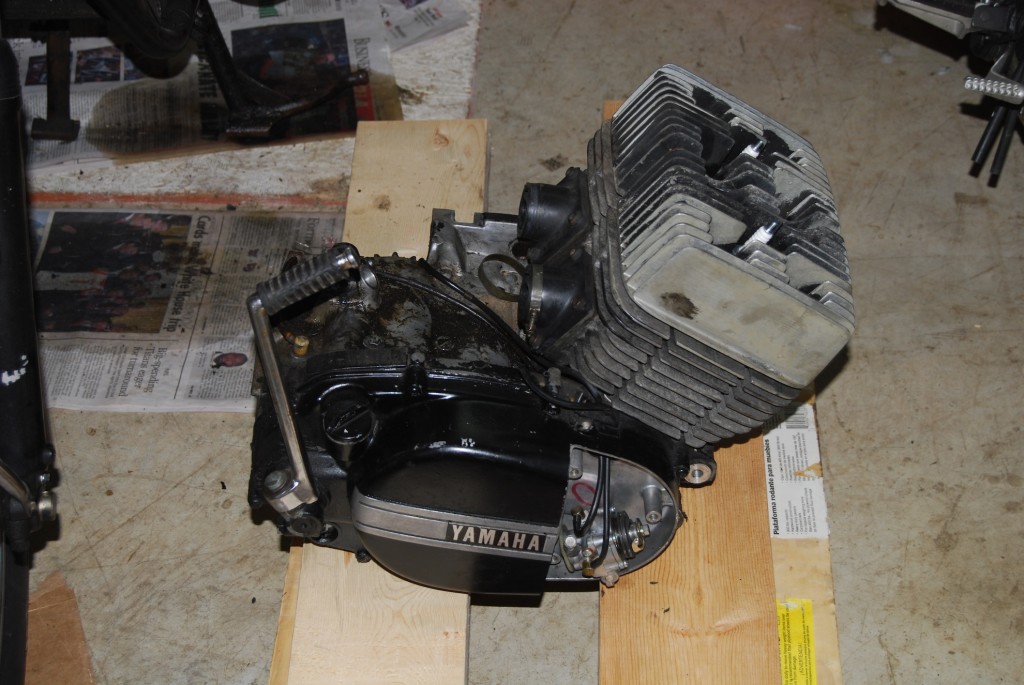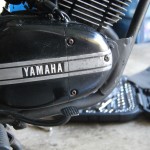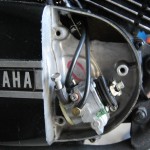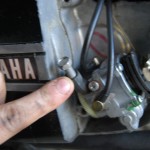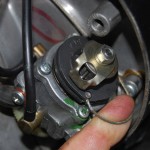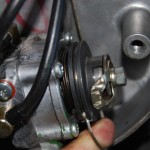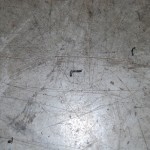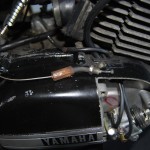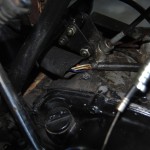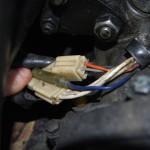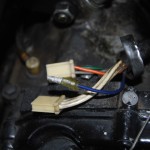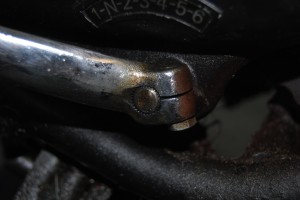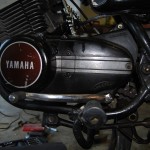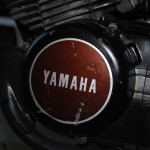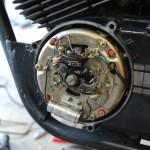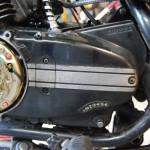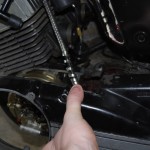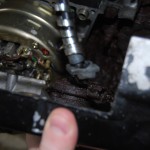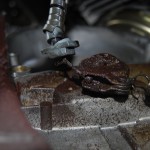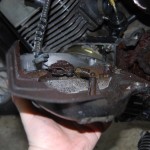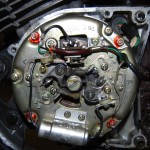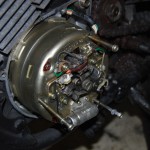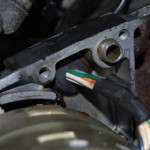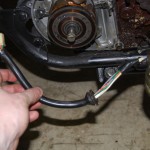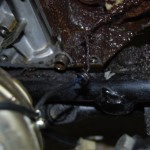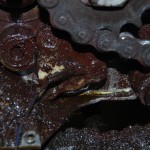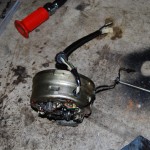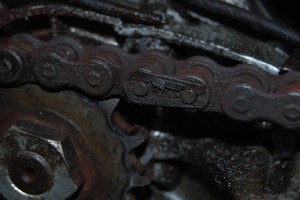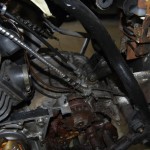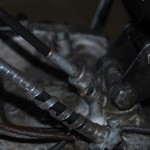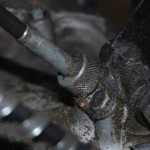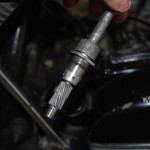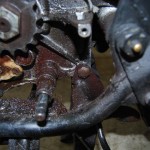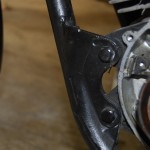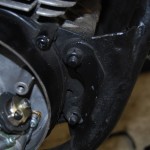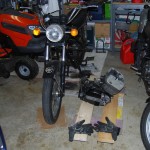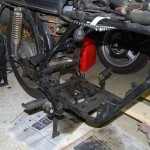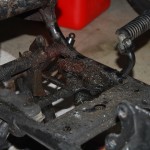With the carbs, tanks and exhaust removed, the next big component to come out is the engine. This bike in particular has a small oil leak somewhere, and likely needs a new gasket. And the frame is in need of some TLC, so the engine needs to go.
Oil Pump Disconnect
On the right side of the crankcase, towards the front, there are three phillips head screws holding on the right crankcase cover. Removing these three screws gives you access to the oil pump. The service manual cautions that the oil pump should be handled with care. In my case, the pump had been disabled, and I got to see exactly HOW in this instance. The throttle control cable was still attached, along with the hoses that went to the carbs, but the feed tube from the oil reservoir had been cut and a bolt wedged into the feed tube. No matter, I’m going to run premix in this bike. The oil tank was long dry, so I didn’t have to worry about draining anything.
Next we want to disconnect the throttle cable, which is attached via a barrel nipple to the pulley on the pump. There was also a small pin that I had to remove in order to allow the cable to be pulled free. Once free of the pump, unscrew the connector on the outside of the crankcase and pull the cable free.
- Left Crankcase Cover Screws
- L-Crankcase cover removed, oil pump shown
- The oil pump inlet line was plugged with a bolt
- I had to remove a small cotter pin to get the throttle cable out
- Another view
- This is the small pin I had to remove
- Unscrew the throttle cable inlet to the top of the left side crankcase.
Electrical Connections to Engine
This step is easy. The harness from the generator connects on the topside of the engine. Check the pictures below for the three connections that need to be pulled.
- Connections on topside of Engine
- Engine Connection Closeup
- Engine Connections Unplugged
Gear Shift Lever Removal
This part’s easy. Theres a pinch bolt that holds the valleys of the gear shift lever against the peaks of the bolt that comes from within the crankcase. Mark where the lever sits if you want to reinstall it as it was, and then unscrew the pinch bolt and pull the lever off the crankcase.
Left Crankcase Removal
This part *should* have been easier than it was for me. First, remove the 3 bolts holding on the generator cover. Then the outer crankcase cover screws can be removed. I was only able to get 1 undone with a screwdriver. The other screw heads were already mangled, and the metal was soft as butter against my screwdrivers. So I ended up with giant holes in place of the phillips head cross for 2 of the 3 screws. I ended up using a Dremel cutting wheel to notch what was left of the head, followed by a manual impact driver. It took several good whacks (partly because these things must have been installed by Hercules, partly because I couldn’t figure out which way on my el cheapo impact screwdriver was ‘loosen’), but I eventually got the screws loosened.
The cover will only pull away a little, because the clutch cable attaches to the interior of the crankcase cover.
- Right Side of Crankcase
- 3 Screws on Generator Cover
- Generator Cover Remvoed
- There are 3 more screws along the outer perimeter (top, right, bottom in this pic). These were a pain.
- Here’s where it pulls free, but we still have to disconnect the clutch cable.
- Crankcase/Clutch Connection
- Crankcase/Clutch Connection Closeup
- Another view of Crankcase/Clutch conneciton
In my Haynes manual, the next step involves further disassembly of the generator and contact breaker assembly. I did a portion of it, which I’ll cover below, but I do not think these parts are necessary for engine removal. Perhaps these are ‘fragile’ parts that you don’t necessarily want lumped with the engine?
I removed the the three long screws holding on the contact breaker assembly, which is where the wires that went to the engine terminate. Removing the large rubber grommet from the back of the crankcase casting was a PITA, but with some small screw drivers to push and pull the grommet, I finally got it out. The cable harness (and connectors) will fit through the hole in the crankcase, and you can pull the entire breaker assembly away. There is a separate neutral contact that will need to be removed (held in via screw). This is where Haynes recommended a Yamaha service tool to remove the generate armature from the end of the crankshaft, and this is where my disassembly stopped.
- View of Generator Assembly
- 3 Generator Screws Removed
- Generator Cables & Grommet (cables to engine)
- Grommet is part of rubber sheath
- The ground wire here has a flat washer connector that must be removed from the crankcase
- Closeup of Ground Wire
- Generator Removed
Chain Removal
With the crankcase cover on the left side removed you can see the front sprocket and full chain system. I found the master link, but could not for the life of me figure out how to get it disconnected. When I was on the verge of losing the therapeutic benefit of working on a motorcycle, I brought back out the Dremel cutting wheel and cut the chain off. I’d likely want a new chain and sprockets anyway, right?
Tachometer Drive Cable Removal
Near the back end of the engine, on top, a cable connects from the tachometer. I removed the screw holding in the bracket and the cable (along with the gear subsystem) came out of the engine. I’m not sure if this is what was supposed to happen. It certainly wasn’t what was described in the Hayes manual, which made it sound like JUST the cable would pull loose. But I was on a roll, so I’ll figure it out later. NOT pictured is the spark plug cable removal, pretty obvious that those have to be disconnected before the engine can be pulled out.
- Throttle Cable
- Throttle Cable Enhance
- Throttle Cable ENHANCE!
- I’m not convinced the gear was supposed to come with the cable, but at least it was disconnected…
Engine Bolt Removal
With the engine completely disconnected from the rest of the bike in terms of oil feed pipes, electrical connections, and driver systems (chain), the last thing to do is remove the 4 large bolts holding the engine in place. There are two pairs, one in the front, and one in the rear. The PO, or perhaps even the PPO, had repainted the frame with these bolts still installed, so it took some effort to break through the paint (just need a bigger ratchet). Remove all 4 screw/nut/washer combos, and then you can put on some heavy gloves and wrestle the engine out of the frame. Make sure you’ve got the bike on it’s center stand. I was able to wrestle it out of the frame (from the right side) by myself. It may have been nice to have someone to stabilize the frame, but it would be difficult to have 4 hands on the engine trying to wriggle it out without pinching anyone. Some people advocate just tipping the frame over and shaking the engine loose, but I didn’t really want to abuse things any more than I had to.
NOTE: One thing I neglected to mention (or take pictures of). are a couple of connections on the TOP of the engine that must be unscrewed prior to the engine being removed. Not sure what these were specifically called, but the look like “C” connectors that could possibly hinge, but definitely must be removed.
- Lower rear engine bolt, the other one is directly above this one.
- Two front engine bolts.
- Other side of front engine bolts, near the right side crankcase cover / oil pump.
That’s it! Engine is out and the bike is a ton (well, maybe not a ton) lighter. Not sure what’s next on the agenda but you’ll be the first to know.
- Engine Removed
- Frame Needs some TLC
- Nasty gunk near front drive sprocket

